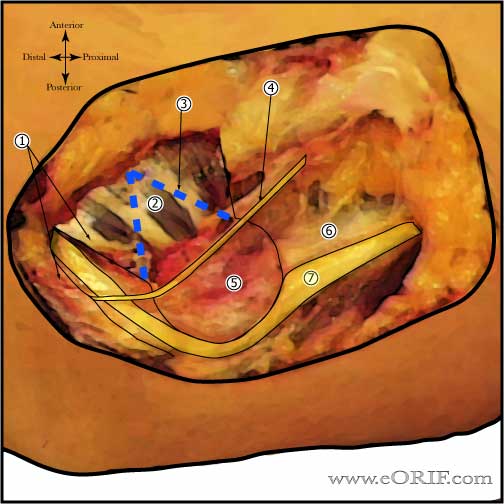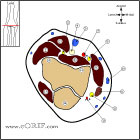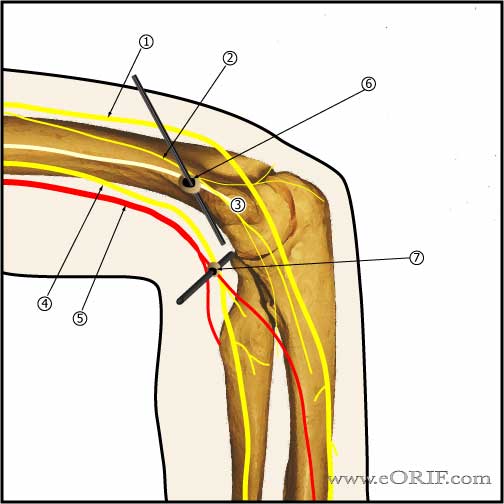|



|
synonyms: ulnar neuritis, ulnar neuropathy, cubital tunnel syndrome
Cubital Tunnel ICD-10
Cubital Tunnel ICD-9
- 354.2 (lesion of ulnar nerve; cubital tunnel)
- 955.2 (injury to peripheral nerve: ulnar nerve)
Cubital Tunnel Etiology / Epidemiology / Natural History
- Ulnar nerve compression from ligament of Struthers
- Associated with elbow flexion activities: telephone use, racket sports, throwing sports, playing musical instruments.
- In throwing sports (baseball) may occur secondary to traction from valgus stress, compression from adhesions, osteophytes, flexor muscle hypertrophy or friction due to subluxation of the nerve.
- Usually 3rd to 6th decade
- Recurrent ulnar nerve subluxation occurs in 16% in the general population (Childress HM, Clin Orthop 1975;108: 168).
Cubital Tunnel Anatomy
- sources=(1)fascial bands, (2)tumors (3)ganglions (4)spurs (5)medial epicondyle nonunion (6)anconeus epitrochlearis (7)cubitus valgus
- Dorsal sensory branch of ulnar N supplies sensation of dorsal ulnar wrist and branches off before wrist.
- Most common site of compression=heads of FCU
- Ligament of Struthers =fascia band from triceps to medial intermuscular septum, generally 8cm from medial epicondyle
- Blood supply: Segmental extraneural and intraneural branches from the superior ulnar collateral, inferior ulnar collateral, and posterior ulnar recurrent arteries. The inferior ulnar collateral artery provides the only direct vascularization proximal to the cubital tunnel. (Yamaguchi K, JSES 1999;8:17)(link is external).
Cubital Tunnel Clinical Evaluation
- Pain and parathesias over small finger, and ulnar half of ring finger and ulnar dorsal hand / wrist.
- Numbness of the ring and little finger, hypothenar wasting, and clawing can be seen with ulnar nerve entrapment at the elbow or wrist. Clawing is generally milder if compression is at the elbow than at the wrist because the FDP is also affected.
- Examine sensation of dorsal ulnar wrist / hand: numbness indicates entrapment above wrist. Normal sensation of dorsal ulnar wrist / hand with other distal signs of ulnar neuropathy indicates Ulnar Tunnel Syndrome.
- Tenderness along ulnar nerve in the Cubital tunnel.
- Elbow flexion test: Hold patients elbow maximally flexed. Reproduction of symptoms of pain and numbness in ulnar nerve distribution within 60 secs indicates cubital tunnel syndrome.
- Tinels at elbow: Place patient's elbow in a flexed postion. Tap over the ulnar notch. Positive result = sensation of tingling or "pins and needles" in the forearm and/or fingers. Indicates cubutal tunnel syndrome.
- Froments sign=FPL compensates for paralyzed adductor pollicis
- Jeanne's sign=compensatory hyperextension of thumb MP joint
- Weakness of ulnar two FDP.
- Brachial Tinnel's sign = compression of ulnar nerve against humerus in proximal arm causes paresthesia in ulnar nerve distibution distally. Indicates cervical spine pathology which will not be corrected by ulnar nerve transposition.
- Palpate ulnar nerve in cubital tunnel through a ROM. Patients with a hypermobile ulnar nerve will demonstrate subluxation of the ulnar nerve over the medial epicondyle with flexion which may be associated with a severe, sharp pain.
- Ensure there is not associated Medial Elbow Instability as a potential underyling cause; especially in throwing athletes.
- Note.
Cubital Tunnel Xray / Diagnositc Tests
- A/P, latera land oblique elbow films indicated, generally normal. May see calcifications in the UCL or arthritic changes.
- EMG / NCV indicated. EMG/NCV is less likely to be abnormal in patients with unlar nerve sublucation because the nerve is not chronically compressed.
Cubital Tunnel Classification / Treatment
- Nonoperative: 50% improve with conservative rx(NSAIDS, activity modifications, night time extension splinting, +/- therapy with modalities, +/- splinting in extension. Consider elbow pad to avoid direct pressure on the nerve. Sleeping with elbow extended.
- Evidence-Based: in situ release (simple decompression) is as efficacious as transposition. Recommendation level: B. (Wright, JG, Evidence-Based Orthopaedics, 2009)
- Surgery=in situ release, epicondylectomy, sub q vs intra-muscular vs submuscular transpostion =80-90% good results when symptoms intermittent and denervation has not occurred. Subcutaneous or submuscular transposition is indicated for throwing athletes. Intrinsic atrophy=poor prognosis. Patients with milder disease have better results after surgery.
- see Ulnar Nerve Transposition.
Cubital Tunnel Associated Injuries / Differential Diagnosis
Cubital Tunnel Complications
- Posterior numbess (medial brachial and antebrachial cutaneous nerve injury)
- Painful neuroma
- CRPS
- Stiffness
- Continued symptoms (paresthesias, weakness, pain)
- Posterior numbess, Painful neuroma, CRPS, Stiffness, Continued symptoms (paresthesias, weakness, pain).
Cubital Tunnel Follow-up Care
- Post-op: allow immediate gentle ROM. No strengthening / lifting heavier than pencil. Submuscular transpostion spling at 45° for 4-6 weeks.
- 7-10 Days: Wound check,
- 6 Weeks: Strengthening / lifting allowed.
- 3 Months: Resume full normal activities.
- 6 Months: assess outcomes.
- 1Yr: assess outcomes.
Cubital Tunnel Review References
- AAOS/ASES Advanced Reconstruction Elbow, 2007(link is external)
- Tomaino MW, AAOS OKO, 2007
- Elhassan B, Steinmann SP. Entrapment neuropathy of the ulnar nerve. J Am Acad Orthop Surg. 2007 Nov;15(11):672-81.
- Zlowodzki M, Chan S, Bhandari M, Kalliainen L, Schubert W. Anterior transposition compared with simple decompression for treatment of cubital tunnel syndrome. A meta-analysis of randomized, controlled trials. J Bone Joint Surg Am. 2007 Dec;89(12):2591-8.
- Mirza A, Reinhart MK, Bove J, Litwa J. Scope-assisted release of the cubital tunnel. J Hand Surg Am. Jan;36(1):147-51.(link is external)
|



